The Risks Of Bird Feeding: Exposing Birds To Unnatural Threats
May 10, 2022
Bird feeding has been a recreational pastime for centuries. The opportunity to see beautiful wild birds close-up to observe their behavior and interact with them brings joy and inspiration to millions, and billions of dollars to the economy. However, like people, birds can get sick. Diseases caused by bacteria and viruses can spread from bird to bird and unsafe bird-feeding practices can contribute to the problem.
Due to the current bird flu outbreak in wild and domestic birds, there has been a lot of controversy over feeding birds, both at feeders, and through hand-outs. Here is what you need to know about the risks that feeding can pose to birds, and some tips for how to avoid them while still enjoying and connecting with such beautiful wildlife.
What Are The Impacts Of Unnatural Feeding?
Unnatural Congregations
In the wild, food sources for birds are scattered, both in space and time. Each tree may have thousands of berries or seeds, but those berries are spread out across the entire tree and each branch will only have a few. Additionally, that tree may only provide food for a couple of weeks, and then the birds will have to move on to the next food source and a different tree. Different species have different favorites among the many varieties of plants and trees that produce fruit and seeds. Stationary feeders, on the other hand, provide food in one tiny area, and often year-round. They also provide a variety of foods, which attract a variety of species. People who go to the same park every day and distribute food in the same spot play a similar role.
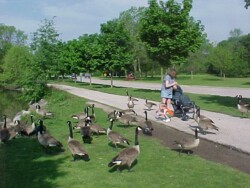
When disease is present in a bird population, wild feeding practices provide a natural form of social distancing. When birds are drawn to feeders or hand-feeding people, it’s an unnatural form of congregation, with the sharing of food and perching space. Birds will quarrel over access to the feeder in skirmishes that put birds into physical contact with other species they may rarely, if ever, interact with in the wild.
Lastly, bird feeding draws birds into areas where they would not naturally be found. While this can increase biodiversity, it also exposes them to potential predators and threats they wouldn’t normally have to deal with, including windows and house cats, the two leading causes of bird death, accounting for over 4 billion bird deaths annually.
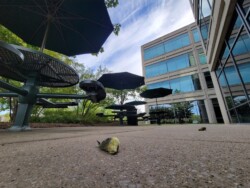
Dirty Conditions At Places Where Birds Congregate To Feed Or Be Fed
Birds poop…a lot, as often as every 15 minutes. All of that waste deposited on and around those feeding locations exposes other birds to disease.
Food spoilage is another risk. Rain can leave seed wet and moldy. Jelly and nectar feeders for orioles and hummingbirds can mold quickly in the sun and heat, which can make birds very sick. The fat in suet can also become rancid in the heat.
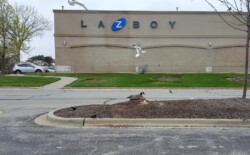
Geese don’t eat while they are incubating. This food left by a well-meaning person will draw predators to her nest or spoil and risk her eggs.
The Risk Of Poor Nutritional Quality
Just like people, the wrong diets expose birds to “junk” food. While most commercially produced feeder seeds are fine, many commercial nectars contain dyes that are not good for hummingbirds. And many people who handfeed waterfowl use bread, which is one of the worst things to feed them. It is difficult to digest and contains very few of the nutrients waterfowl need to grow and develop properly. This can cause issues like “angel-wing,” a deformation of the bones in the wing, leading to feathers that grow in a swirl and stick out. These birds can’t fly, and the condition is usually permanent.
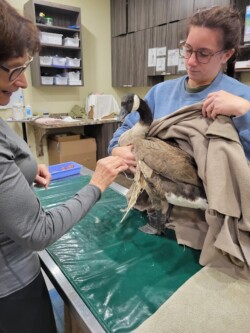
Young Canada goose with angel wing rescued from a park where a lot of bread feeding takes place. The goose, which was underweight and malnourished, was taken to a sanctuary and would not have survived in the wild.
Do We Need To Stop Feeding Birds?
The short answer is… sometimes. Experts never recommend hand-feeding birds, especially waterfowl. Waterfowl are especially prone to diseases like bird flu, avian botulism, and more from gathering around hand-feeding sites. It also leaves them unwary and can increase attacks from protective geese and swans and bring them into contact with vehicles and aggressive pets. It is also bad for the environment. For all of these reasons, many municipalities prohibit hand-feeding of birds in public parks.
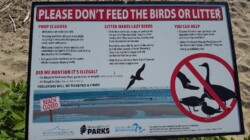
For stationary feeders, it is best to follow the recommendations of experts, who advise against the use of feeders when there is a bird disease in your area. Birds rarely need us to feed them to survive. This doesn’t mean we should never engage in bird feeding, just that we should do so with their best interests in mind.
Steps To Reduce The Risks Of Feeding Birds
- Reduce Congregations. Keep space between feeders and have each feeder offer a different type of seed or food. This will spread out different species of birds and create a more natural feeding area.
- Keep Areas Clean. Thoroughly clean bird feeders with a 10% bleach solution at least every other week. Make sure all seed remains dry or change it out after a rain. Clean up underneath feeders to reduce seeds and casings building up and spoiling. Make sure the ground under the feeder has good drainage as well so that seed underneath doesn’t mold after a rain. Clean hummingbird feeders weekly, and more often in hot weather.
- Protect From Outside Risks. Keep all domestic cats indoors and treat your windows to prevent collisions.
- Feed Nutritious Foods. Make sure you are selecting foods that are nutritious and safe for birds to eat. Offering a variety also allows birds to choose based on their needs.
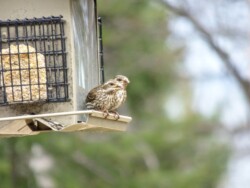
At Wild Goose Chase Indy, our work in providing farmers, property managers and others with solutions to their bird conflicts overlaps with our deep respect for these amazing creatures. Our bird deterrent solutions are designed and overseen by a biologist-led team of bird experts to ensure safe, humane, and effective strategies for coexistence between birds and people.
Give us a call to learn more about our strategies for preventing crop loss, for managing populations of Canada geese and a wide variety of other services relied on by our clients across the Midwest.


 0
0
